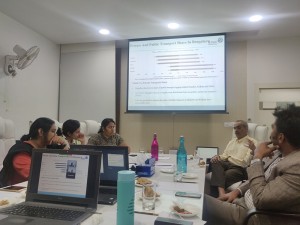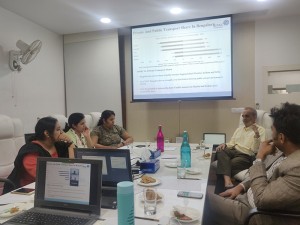Round table discussion -‘Incentivising shift from private transport’
Context:
Bengaluru has a lower share of public transport lagging behind Mumbai, Kolkata and Delhi, having usage of 80-81%*, whereas Bengaluru having about 45-49%*. The private vehicles registered in Bengaluru is nearly 8 million during the year 2018, which was 2.1 million in 2007 as per Regional Transport Office (RTO), Karnataka. There is a clear indication of growing private vehicles in the city crossing more than 8 million which includes vehicles registered out of Bengaluru, running in the city. Bengaluru city spread across 824 km² with 15,000 km of roads network which are mostly four-lane carriageway network.
On an average, Bengaluru witnesses approximately 100 – 110 lakh trips every day, out of which 35 – 42 lakh trips are through BMTC buses, 4 – 4.5 lakh trips are through metro rail services. Over the years the number of trips by suburban rail has considerably increased. A large portion of these daily trips in the city are through privately owned vehicles, auto-rickshaws, cabs and shared mobility services.
The increasing congestion and growing levels of vehicular pollution in the city needs a holistic approach by the Government through establishing/facilitating adequate necessary infrastructure for the use of public transport services, connectivity and policy intervention to drive citizens to shift away from private modes and move towards public or shared transport.
With this background, B.PAC and Uber under its initiative of “Sustainable Mobility for Bengaluru”, organised a roundtable discussion titled ‘Incentivising shift away from private transport’ on September 27th, 2019 at the B.PAC office. The debate had representation from civic groups, subject matter experts, former Government officials and think tanks. During the roundtable meeting, participating members emphasised and highlighted the kind of incentives and disincentives suitable for Bengaluru city to shift from private transport and adopt public and shared transport services.
Following are the major points discussed during the roundtable meeting and can be classified under the following themes:
1.Current status of Mass Public Transport services in Bengaluru:
- BMTC: Widening gap in demand and supply – Fleet strength of BMTC has increased only by 7.89% since 2011, whereas the population has increased by 32%. Present fleet strength is approximately 6,635. BMTC buses earlier used to cover 230 km per day which has fallen to 180 km per day indicating a drop in service level and not able to meet the schedule due to traffic congestion on city roads
- BMRCL: Two metro lines currently in operation, running 42.3 km around the city. When completed, Phase II is expected to have a daily ridership of 20 lakh people. The metro currently has a daily ridership of 4,53,744
- Suburban Rail: The current suburban rail system is of 120Km (Challa & Shivananda, 2017). In the revised detailed project report, 29 stations have been dropped, bringing the total down from 82 to 53 (The Hindu, 2019)
Key suggestions to upgrade services offered by BMTC
- Simplifying the numbering system of buses and passenger information system to suit a citizen-friendly environment
- Leveraging technology and tools that are usable by BMTC staff
- BMTC should be looking into different forms with different capacity of buses for narrow roads providing first and last-mile connectivity to major transportation hubs of BMTC, BMRCL and Suburban Rail stations
- Complete the route optimisation in all segments
- City bus services to be treated equivalently with Namma metro services. Government to consider increasing subsidy/grants to BMTC for increasing the number of buses and extend the services in the identified High-density corridors and provide viability gap funding for meeting the operational requirements of the bus services.
- BMTC should move from being an operator to becoming a regulator or enabler
2.Incentives and Disincentives for shift from private transport
There are various models adopted by countries which act as disincentives and incentives and their impacts which were discussed.
- Congestion pricing
- Parking fees
- Transit plus zones
- Dynamic lanes
- Priority lanes for shared mobility and public transport
The discussion for this roundtable revolved on models of incentivising people to use shared mobility while also implementing certain models for disincentivizing private vehicle usage in high-density traffic corridors with similar kind of population travelling. Below High Traffic Density Corridors (HTDC) has relatively homogeneous travel patterns from origin to destination during the weekdays from residential locations to hub housing jobs.
-
- Old Airport Road
- Outer Ring Road (ORR) Hebbal to Silk board via K R Puram
- Remaining ORR -Silk board to Hebbal via Yeshwantpur
- Bellary Road | Hebbal to KIAL road
- Sarjapur Road
- Inner ring road – Old Madras road to Hosur road via Koramangala
Other High Traffic Density corridors (HTDC) in Bengaluru
-
- Hosur Road
- Old Madras Road
- Mysore Road
- Bannerghatta Road
- Kanakapura Road
- Magadi Road
- Tumkur Road | West of Chord Road
Initiatives which could be adopted in the HTDC are:
- Single card for payments – Public transport and shared mobility options
- For multi-mode interchange, minimum fare on every mode needs to be removed. Integrated method of payment needs to be in place.
- Local area parking permit: Any parking on the road, even though in front of the house needs to be charged
- Dynamic lanes need to be worked on for potential areas and during peak times
- Priority lanes for public transport by flooding the network, making buses automatically occupy the left lane and shared mobility lanes for cars having occupancy with three or more to get into the faster lane.
- ITS in public transport – Passenger Information System
- Quicker and efficient first and last-mile connectivity for public transport
3.Need of Unified Metropolitan Transportation Authority(UMTA) with a financing mechanism
4.Removal of encroachments on roadsides in High-Density corridors which creates roadside friction and affects efficient vehicular movement.
The roundtable discussion organised by B.PAC and UBER provided a platform for participating members to discuss and deliberate on the critical requirements on the kind of incentives that could be adopted for within city transportation, especially in High-Density corridors of Bengaluru by means of strengthening and implementing efficient mass public transport system in the city.



